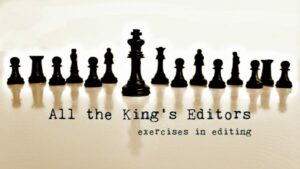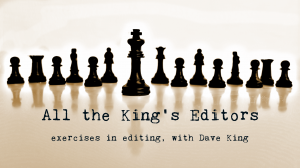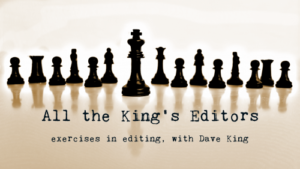Posts by Dave King
This morning’s Editor’s Clinic, the opening pages of a novel, follows the protagonist, Sylvie, as she sinks into a panic attack triggered by seeing her third-grade daughter picked up by her soccer coach. It’s a sharp opening, tense in its own right and implying a dramatic backstory — why should seeing Coach’s innocent play trigger that kind of panic?
As you can see, most of the editing I’ve done has been aimed at amplifying these strengths. I’ve cut a fair amount of repetition, to keep things focused and flowing, and have introduced a couple of bits of interior monologue to make it clearer that the attack is triggered by her daughter.
I don’t always avoid the other parents at my daughter’s soccer games, but it’s too hot today to put on my pretend extrovert mask. Twin trickles of sweat drizzle down the backs of my legs and I swipe a sweaty hand down my calf, slick skin meeting slicker skin.[1]
Why iwas Coach Mack swinging that little girl? Up and around. Uup and around. L long skinny limbs flailing, baby hairs glinting in the sun, flailing like a minute windmill stuttering to life.[2] He should pPut her down. It wa’s time for warm-up drills, not a carnival free for all. [3]
A group of third-grade girls, indistinguishable in their long ponytails and baggy, green soccer uniforms, circle Coach Mack acrosson the other side of the soccer field begging for a turn. Their shrieks and shouts mix with the screech of gulls trolling Lake Michigan. I can’t spot her at this distance, but Cassie must be among them. [4]
I’m having trouble The muggy air makes it hard to takinge in a full breath. It must be the muggy air. On a day with thick, moist air this saturated, I need giant maxi pads to soak up the humidity.[5] But why are my teeth chattering, the staccato knocking making a ticking sound in my brain?
Other parents, hugging and talking chatting in small clusters on the sidelines, seem oblivious to what Coach Mack is doing’s antics. Before I can get their attention, a loud, drawn out tire screech from a car skidding up Lake Shore Drive drowns my words. [6]
When I turn back to the field, Coach has set one girl down and reaches his thick hands toward another, the sun crowning him like an ancient god.
Cassie. My vision blurs at the edges, and I squeeze my eyes shut.
Tiny pinpricks of heat tingle around my lips. My throat constricts and I can’t force enough air in my lungs. Strangled from the inside. Can’t move, can’t breathe, can’t think. The ticking sound pulses my brain.
Stop, please stop. [7]
A hand touches my elbow from behind. I yank my arm away and turn to face a mom whose name I can’t remember. The woman, chinless and shiny, flashes an oversized greeting card in my face and asks me to sign my name. Some sort of end-of-season thank you for Coach Mack. Her voice clogs in my ears like waves of sound pounding through a drum.
Then she drops the […]
Read MoreThe Lutheran church where I’m organist uses an electronic instrument in a choir loft above the sanctuary. The organ’s three huge speaker banks are hung off the loft rail so they project out over the congregation. Which is fine, except that when the congregation is going all out (Lutherans tend to be full-throated singers), I can’t hear myself play. Essentially, I’m playing on trust.
I thought about this as I read the comments on some of the Editor’s Clinic pieces. So many readers would like to change the focus of the narrative — to cut a bit of character-building interior monologue in order to speed up the action, or to pause the action to explore a relationship that may or may not be important later. This raises the question: how do you know how your writing comes across to your readership? How do you tell when you’re feeding them so much information you’re boring them, or so little that you’re leaving them confused? Do your readers see your characters as the same people you do? Have your surprises come as a surprise, or were your readers just waiting for you to spring your reveal and move on? How do you know?
Well, you can’t, not really. Remember, your readership isn’t a monolithic block who will all feel the same way about your story. If you, say, leave out some of the more obvious steps in your detective’s thinking, some readers will appreciate the way you assume they can follow along, while others will simply be lost and resentful. If you spend time developing a personal relationship that helps showcase your main character, some readers are going to appreciate knowing your protagonist better while others are going to be impatient for the story to keep moving.
Read MoreI’ve written before about the dangers of working too hard to create your hook. That’s what I believe you’re doing here. The big shock of your opening scene is that your narrator was expected to eat a chicken that had become a pet. But I think the drive to hook your readers quickly led you to pack that shock into your opening sentence.
But this reduces that key reveal to simple information. The fact is shocking in the abstract, yes, but your readers learn it before they know anything about your narrator or her situation. They don’t have any emotional connection to the person the shock is happening to. You can create that emotional connection just by delaying the reveal by half a page or so.
You’ve also fallen into the trap of feeding your readers the background they need to know as quickly as possible. Except that you’re doing it at the expense of your narrator’s character – having her think of things that she would, in real life, take for granted. Once again, this gets information to your readers, but undermines the emotional connection they’re forming with the narrator.
Remember, the thing that draws your readers into your story most is that they care about your main character. When you take the focus off your narrator to do other, less important things (like shocking your readers or filling them in on background) you leave them caring less. Every writing book or blog will tell you that you need to hook your readers quickly. But don’t be so obsessed with the hook that you forget where your true story lies.
Chapter 1
I couldn’t eat my best friend, even if she was a chicken. You’d think I would have known what to expect after she stopped laying eggs. One day, when I returned home after cleaning hotel rooms, Mama handed me the mixing stick as soon as I walked into the village. [1] I almost refused, but if I were going to eat, it was only fair I helped cook. Besides, the Ssun warmed my aching shoulders as I stirred the rainwater stew.
Villagers who added rice and yams circled around, singing about the food we would eat. As I listened, mMy mouth watered and my stomach rumbled. But something was missing. [2]
Read More
Welcome back to All the King’s Editors, our regular feature — more or less twice a month — in which one of Writer Unboxed’s stable of editors line-edits a few pages that one of you has submitted. This gives you a chance to see editing advice applied in its natural habitat.
If you’d like to contribute a sample to be edited, click HERE for instructions. Remember, editing is as much art as science, and your take on the passage may differ from mine. If so, feel free to join in the discussion at the end.
I hate sirens. E, especially at night., Whenever I hear one, slicing through the silence like, sharp as a scalpel. Whenever I hear the screech of an ambulance, I make the sign of the cross. My mother taught me that. “It’s a silent prayer,” she my mother always said. I can’t help but always wonder what awful event the ambulance is rushing toward, triggered a frantic call to 911 and if my prayer made a difference.
But, I’m shaking too much at the moment to make the sign of the cross. Because tonight, I’m the eventand right now, the gesture feels pathetic, inadequate. [1]
Read MoreThe comments section, where readers start bringing their own intelligence and experience to the conversation, is often the best part of a Writer Unboxed article. For instance, three months ago, I talked about what the music of J. S. Bach can teach us about setting up surprise in fiction. Donald Maass then got on in the comments and gave an elegant summary of the different flavors of surprise.
Since surprise is so critical to good storytelling – predictability is boring — I’d like to expand on Don’s comments (with his permission). Because it’s important to not only understand what surprise is, but to understand just how you can pull it off. A warning up front: spoilers abound.
“In one way, surprise is nothing more than what you, the author, know will happen that the reader doesn’t. Don’t tell. Lead the reader to expect something else.”
Generations of mystery writers have developed techniques for leading the reader to expect something else, and we can only cover a couple here. But the clue-hiding techniques set up surprise at its most basic, so they make a good place to start.
The most basic technique is to throw a lot of details at your readers so the essential facts get lost in the weeds. And just because this technique is basic doesn’t mean the novels that use it are second rate. In Who’s Body, Dorothy Sayers buried the critical detail that the suspect was a mountain climber (and thus able to rappel down from the roof and deposit the mysterious body) among details of schooling and employment history in the character’s Who’s Who entry.
Read MoreThere’s a limit to what you can learn about writing from reading about it. Yes, articles can explain techniques you can use or point out traps you might fall into. They can help you see some aspects of your writing more clearly.
But when you try to put all this advice into play, you find that everything is connected to everything else. Changing one character’s voice can affect how other characters react to him or her, which could change the direction of your plot. Describing a setting in more detail might color the mood of the scene, so that the dialogue no longer seems to fit quite so well. Even a mechanical change like how often you paragraph can increase your pace and affect the amount of detail you need to include.
Which is why we’re kicking off a new feature here at Writer Unboxed — the Editor’s Clinic. We’re asking brave volunteers to submit a few pages from their work in progress. (This initial example is from a client, used with his permission.) Then I or one of the WU editorial stable will work our magic and post the results here. And this gives you a chance to see how editors apply writing advice in its natural habitat. It gives us a chance to get away from the theoretical and get real.
If you’d like to give it a go, you can send a sample of your work (no more than five pages) to dave@davekingedits.com. Feel free to include any questions you might have about the passage, and we’ll try to get them answered. And please feel free to join in the discussion — they’re often the best part of the article.
We’re still feeling our way with this, so we’re not sure yet how often the clinic will appear or who the editorial stable will include. But I’ve done similar things in the past, and they’ve been a lot of fun.
So watch this space.
And here’s the opening sample. The narrator, April, is being stalked by Josh, someone she used to know. Richard is the current boyfriend. The notes appear at the end.
Read MoreThe 1884 two manual, 14-rank Hook and Hastings, Trinity Church, Shelburne Falls, MA.
Once again, a look at what J. S. Bach, and particularly the Fantasia and Fugue in A minor, has to say about writing. If you’ll remember, last time we looked at suspense. This time, we’re looking at surprise.
Read MoreI ran into this delicious exchange in a client’s manuscript the other day. Rosemarie, a young virgin, is being seduced by the one eyed man. She distrusts him, she’s frightened, and she’s awash in guilt for the physical attraction she feels toward him.
‘No,’ said Rosemarie. ‘This isn’t right.’
‘No one’s watching,’ whispered the one eyed man.
Creating dialogue with clear, unique character voices can’t be done by rote. But it’s not magic, either. I’ve written before about techniques you can use to enhance your character’s voice and tools you can bring to bear on stiff and formal dialogue. Another way to make your dialogue more authentic and memorable by to make it less explicit. It becomes more real when you leave things out.
Consider how much character conflict is going on behind the two lines quoted above. Being seen is the least of Rosemarie’s objections to the seduction, yet that’s what the one eyed man focuses on. He ignores all of her stronger objections, replaces them with a straw man, and knocks the straw man down. Yet he knows that losing that straw man is all the encouragement Rosemarie needs to give in. He shows himself to be insightful into what’s going on in her head and selfish and manipulative enough to use it against her. And the three words that capture all of that complex characterization are sharp and memorable because so little of it is spelled out.
To one degree or another, all conversations contain subtext – conscious or unconscious assumptions, hidden agendas, or clandestine motives lying behind the speaker’s words. And if you don’t pay attention to subtext, you’ll wind up writing dialogue where all your characters have the same subtext. Readers may not be conscious of it — you may not be conscious of it — but your characters are going to feel subtly the same because, under the surface, they all want the same thing from the conversation. You’ll never see the complex conflict that exists between the one eyed man and Rosemarie because everything in your dialogue is out in the open.
It’s been said that, when he was teaching acting classes, Elia Kazan would often give a couple of students each a slip of paper describing a situation, then ask them to improvise a scene. Thing is, he gave them two different situations. As they improvised, each one seeing the world slightly differently, their dialogue took on some of the confused authenticity and sparkle of real life.
Read MoreConsider this opening paragraph, from an essay included in G. K. Chesterton’s 1928 collection, Generally Speaking:
Among those remarkable “Sayings of the Day” that are quoted in the daily Press, I remember a sentence that is quite significant. Sandwiched in between two other epigrams, between Sir Humphrey Pumpernickle’s paradox, “The British Empire must look to Britons for its defence” and the equally arresting bon mot of the Dean of Ditchbury, “True religion includes the desire for truth” — interposed, I say, in the same setting between some such jewels as these, I find a remark that really seems to me to be a text for a philosopher. I have forgotten who said it; but he was somebody of a social importance equal to that of the great men I have named. And what he said was this . . .
Earlier this year we talked about how to generate suspense by giving your readers a sense of what’s to come while preserving some ambiguity about it, then holding back on the revelation as long as you plausibly can. This is exactly what Chesterton does here. The mock quotes from other notables let readers know that what’s coming is going to be equally ridiculous, and that Chesterton is going to have suitable fun with it. But Chesterton holds off the quote itself as long as he can, just to whet readers’ appetites for the big reveal.
Any good essay – or any good non-fiction writing – presents ideas clearly and with a logical flow. But the best essays, the ones that are a pleasure to read and stick with you afterwards, also use techniques you usually think of as belonging to fiction. They essentially treat ideas as characters and tell a story about them.
Just about any long-form piece of nonfiction in The New Yorker makes use of several fictional techniques. Take Eliza Griswold’s recent piece on the future of the coal industry. Note how Griswold starts by setting the scene for her ideas with a description the countryside in Greene County, Pennsylvania, and ties the ideas to an activist named Veronica Coptis. Then, for the rest of the piece, ideas like the economic impact of closing the mines or the relationship between mines and environmental regulations are interspersed with trips back to the setting and Coptis’ life. This not only humanizes the ideas and gives them meaning. It lets Griswold release information to her readers at a controlled pace that would do a spy thriller proud.
Roy Blount once wrote an essay on the contrast between dog and cat ownership. For most of it, he sketches out all the complaints dog lovers have against cats – they’re emotionally indifferent, they’re self-involved, they’re impenetrable. And then, in a surprise that would have been at home in the denouement of any mystery, he concludes that you should really own a cat for all the reasons he’s just listed against them. Cats are like poems – short, perhaps hard to understand, but comforting without being emotionally demanding. “Dogs are like Dickens.”
Read MoreHarold Abrahams at the 1924 Olympics
In the classic film Chariots of Fire, Olympic sprinter Harold Abrahams hires a coach, Sam Mussabini, to help him win the 100-yard dash. Mussabini first lays out a string of coins, representing the steps Harold takes in a typical race. Then he pushes the coins together slightly and says, “Can you find me another two coins, Mr. Abrahams?”
This is what editors do. Because we can bring years of experience and fresh eyes to your manuscript, we can spot weaknesses that you didn’t know you had. An editor can see where your characters act out of character. We can spot when you aren’t including enough detail (or including too much) when you set your scenes. We can tell you that the subplot that you thought highlighted your main character actually slows your pace more than it’s worth. We can find you two coins in the hundred.
Unfortunately, some editors try to do more.
I recently had a client come to me after working with three other editors who had all left distinctive marks on her manuscript. One suggested that she take what was, in fact, a prologue and make it into chapter one, because books nowadays shouldn’t have prologues. Another told her she needed to humanize her main character more, so she added a scene at the beginning that delayed the start of the real story. The third said the story started too late, and she should jump ahead, losing much of the humanizing material she’d just added.
The point here is not that the editors offered bad or contradictory advice – we all get it wrong from time to time. It’s that all of their advice pushed the client to make changes she didn’t feel comfortable with. They weren’t just adding steps to her race. They were trying to run the race for her.
Read MoreRemember, your readers want an opening that takes them somewhere. Image from Creative Commons
An agent once told me that she reads the first sentence of a manuscript. If she likes it, she reads the second, then the third. If she finishes the manuscript, she signs it up.
I suspect most readers are willing to give you a little more leeway than that, but there’s a reason so many workshops, online discussions, articles, and writing books focus on your hook – your first five pages, your opening page, even your first paragraph. Most readers buy books because they know what they’ll be getting. Writers with an established reputation can take their time getting into their stories because they know their readers will stick with them until the story’s underway. But if you’re just starting out, readers are less likely to trust you for a chapter or two. Those opening paragraphs may be the only chance you get to suck them into your fictional world.
But obsessing over your opening paragraphs carries its own risks. You may try to pack so much tension, so much hook into your opening that you wind up writing page one in a voice that doesn’t match page two. Many years ago, I worked with a client who was trying so hard to impress her readers with her hook that her first few pages were unreadably self-conscious. She didn’t settle down to clear prose until about page 10.
Or you could wind up with a brilliant, precisely-crafted, exciting hook that’s not actually part of your story. Years ago, I edited a novel about a Viet Nam nurse that opened with the high drama of a field hospital, then followed her career through the war. Thing is, the main story was less about the nurse’s battlefield experience as about how it affected her when she returned home. Opening in Nam delayed the start of the story for a hundred pages or so, until the writer managed to get the nurse back to the States. In her next draft, the nurse had a flashback-induced panic attack while she was giving birth and wound up huddled under her hospital bed, and things went on from there. It was not quite as exciting as the battlefield, but it pulled readers straight into the story.
Read More“The Lady or the Tiger,” a 19th century short story by Frank Stockton, tells of a commoner who falls in love with a princess in a semi-barbaric kingdom somewhere in the East. When the lovers are caught, the commoner is subjected to a trial by ordeal in which he is led into an arena and forced to choose one of two doors. Behind one door is a beautiful woman whom the commoner must marry. Behind the other is a hungry tiger. The commoner’s choice will determine his innocence or guilt.
But the princess has learned which door holds what. She’s also learned that the beautiful woman is a hated rival. So when the commoner is escorted into the arena, she nods to the door to the right. The question is, does the princess want her lover to live, or would she rather see him killed in front of her than married to her rival? The commoner opens the door . . .
And that’s where the story stops.
I’ve written a lot about how important it is for your writing to feel like real life. If it feels at all contrived, your readers will lose their suspension of disbelief. This is most critical with your ending. Readers expect you to start out your story by presenting some sort of problem that needs to be resolved. Then, as you develop that problem and the characters it’s happening to, it’s not too hard to make events seem as haphazard and ad hoc as real life. But your ending is where you pull all your plot threads together, often with some unexpected twist you may have set up chapters earlier. All the contrivance in your story gets distilled into your ending.
Read MoreIn last month’s music video, I mentioned that suspense rests on the suspension of disbelief. If readers feel your story is contrived, they aren’t going to care how it turns out. In the comments, someone asked how you suspend disbelief when you’re writing about something inherently implausible like, say, vampires taking over a small New England town.
Of course, if you’re writing light comedy or satire, then it’s a lot easier to get readers to suspend disbelief. But most suspense novels depend on readers feeling the reality of whatever horrors you’re inflicting on your characters. So do most thrillers. And you often need readers to suspend disbelief about improbable events in police procedurals, or science fiction, or even cozy mysteries that have to explain why a retired governess turns out to be a stellar detective.
Stephen King is a master of making the outrageous and macabre seem real. One of his techniques is to frame his central implausibility – that small town in Maine being taken over by vampires — in a completely ordinary setting. By introducing readers to the thoroughly normal world of Jerusalem’s Lot, Maine, with the Excellent Café, the old guys hanging outside of Milt Crossen’s agriculture store, and Dud Rogers running the town dump, King anchors his readers firmly in the mundane reality of small-town New England.
Note, by the way, that King doesn’t give into the temptation to turn the town into an idyllic place. The newlywed McDougles in their trailer are dealing rather badly with each other and their toddler – there is hitting involved. And Dud Rogers down at the dump amuses himself by shooting rats. But by not going for the sharp contrast between the good town and the evil that invades it, King makes both the town and the evil feel more real.
He doesn’t let go of that ordinariness even as Dud Rogers starts stalking the dump’s patrons, the McDougles (including the toddler) take to hiding in the crawlspace below the trailer to avoid the sun, and the old guys outside the ag store simply disappear. Even while more and more of the town’s residents are being caught, drained of their blood, and turned into servants of the evil one, people are still eating reheated hamburgers from the McDonald’s in the next town over and getting home-canned corn from the metal shelves in the basement. And the Excellent Café is the last town business to close its doors.
Read More




















